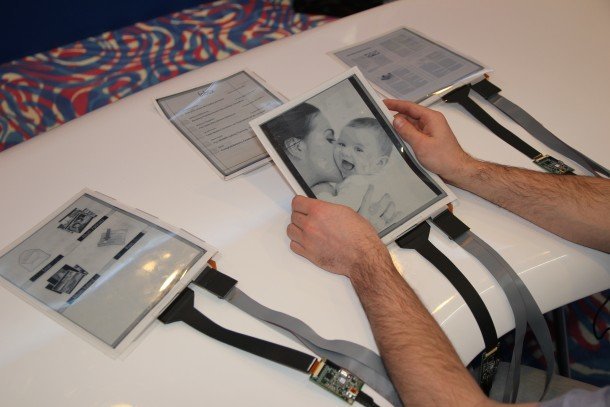
Video: Electronic Paper Gets Interactive, But Still Pretty Rough
January 7, 2013 by Dave Haynes
Electronic ink and e-paper technology has been around for more than a decade now, and while there have been some great strides, it’s pretty clear there is still a loooong way to go before this display technology takes more than a very basic role in digital signage projects.
This is a video from the Human Media Lab, up Hwy. 401 on the other side of Toronto, past Lyle Bunn’s house, at Queens University in Kingston.
Says a news release:
A flexible paper computer developed at Queen’s University in collaboration with Plastic Logic and Intel Labs will revolutionize the way people work with tablets and computers. The PaperTab tablet looks and feels just like a sheet of paper. However, it is fully interactive with a flexible, high-resolution 10.7″ plastic display developed by Plastic Logic, a flexible touchscreen, and powered by the second generation Intel® Core i5 processor. Instead of using several apps or windows on a single display, users have ten or more interactive displays or “papertabs”: one per app in use.
Ryan Brotman, research scientist at Intel elaborates: “We are actively exploring disruptive user experiences. the ‘PaperTab’ project, developed by the Human Media Lab at Queen’s University and Plastic Logic, demonstrates innovative interactions powered by Intel core processors that could potentially delight tablet users in the future.”
“Using several PaperTabs makes it much easier to work with multiple documents,” says Roel Vertegaal, director of Queen’s University’s Human Media Lab. “Within five to ten years, most computers, from ultra-notebooks to tablets, will look and feel just like these sheets of printed color paper.”
“Plastic Logic’s flexible plastic displays are completely transformational in terms of product interaction. they allow a natural human interaction with electronic paper, being lighter, thinner and more robust compared with today’s standard glass-based displays. this is just one example of the innovative revolutionary design approaches enabled by flexible displays,” explains Indro Mukerjee, CEO of Plastic Logic.
If you are CES this week you can see a demo, presumably at an Intel booth.
If you watch the video, you’ll see it is still black and white and the refresh rates are painfully slow, even though the media is being driven by a pretty spankin’ fast Intel CPU.
The tablet applications are kinda sorta interesting, but LCD and tablet/smartphone technology is so far ahead of this. Then again, this is a lab. They’re trying stuff out and thinking beyond how things are now done.
Electronic ink gets interesting for digital signage when it is color, full motion, crisp and flexible. It looks like there’s a way to go before all those boxes are ticked, not to mention the big one: cheap.



Leave a comment